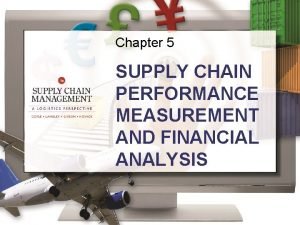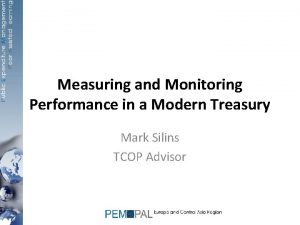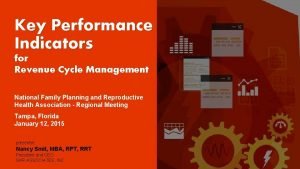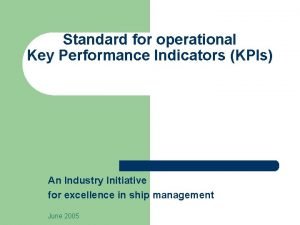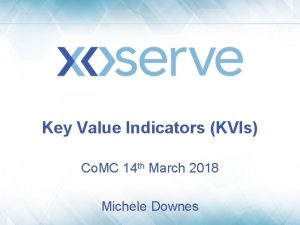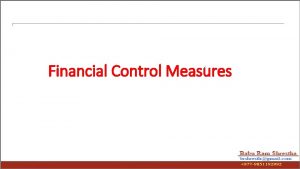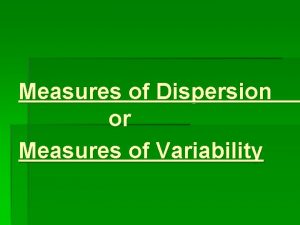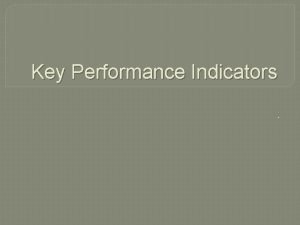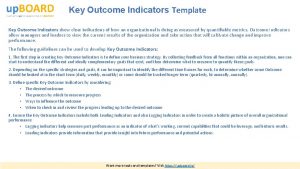Key Financial Indicators Key Financial Indicators Measures of













- Slides: 13

Key Financial Indicators

Key Financial Indicators üMeasures of liquidity v. See equations 1 and 2; page 12 of booklet üMeasures of solvency v. See equations 3 – 6; page 13 of booklet üMeasures of profitability v. See equations 7 – 9; page 13 of booklet üMeasures of economic efficiency v. See equations 10 – 14; page 14 of booklet üMeasures of debt repayment capacity v. See equations 15 – 17; page 15 of booklet

Measures of Asset Liquidity 1. Current ratio: ratio • Current assets divided by current liabilities. • Demonstrates ability to cover scheduled current liabilities for the coming year out current assets and still have “cash” left over. • Should exceed 1. 0 to be technically liquid. • Some firms fail despite exceeding this hurdle.

Measures of Asset Liquidity 1. Current ratio: ratio • Current assets divided by current liabilities. • Demonstrates ability to cover scheduled current liabilities for the coming year out current assets and still have “cash” left over. • Should exceed 1. 0 to be technically liquid. • Some firms fail despite exceeding this hurdle. 2. Working capital: capital • Current assets minus current liabilities. • Expresses liquidity in dollars rather than ratio. • Should be positive. • Cash is King!

Measures of Credit Liquidity 1. Unused credit reserves: reserves • LOC extended by lender less current loans on LOC. • Demonstrates ability to cover scheduled current liabilities for the coming year out existing available credit. • Should positive to be technically liquid. • Will cover the implicit cost of credit liquidity later in the course.

Measures of Cash Flow Liquidity 1. Monthly cash position: position • Monthly surplus of cash available less cash required. • Demonstrates ability to cover scheduled current liabilities for a particular month out expected surplus cash. • Should positive to be technically liquid. • This requires maintenance of a monthly cash flow statement.

Measures of Solvency 1. Debt ratio: ratio • Total debt divided by total liabilities. • Demonstrates ability to liquidate the firm, cover all liabilities out of all assets, and still have “cash” left over. • Should not exceed 0. 50 to minimize financial risk exposure. • Some firms fail however at lower levels.

Measures of Solvency 1. Debt ratio: ratio • Total debt divided by total liabilities. • Demonstrates ability to liquidate the firm, cover all liabilities out of all assets, and still have “cash” left over. • Should not exceed 0. 50 to minimize financial risk exposure. • Some firms fail however at lower levels. 2. Leverage ratio: ratio • Total debt divided by equity or net worth. • Often a credit standard in loan approval decisions. • Should not exceed 1. 0 to minimize financial risk exposure. • Effects of rising interest rates.

Measures of Profitability 1. Rate of return on assets: assets • Net income before interest and taxes divided by average assets during the year. • Demonstrates the accrual adjusted pre-tax return to management total capital invested in the firm. • Should be positive; the higher the better.

Measures of Profitability 1. Rate of return on assets: assets • Net income before interest and taxes divided by average assets during the year. • Demonstrates the accrual adjusted pre-tax return to management total capital invested in the firm. • Should be positive; the higher the better. 2. Rate of return on equity: equity • Net income before interest and taxes divided equity. • Demonstrates return on owner equity invested in the firm. • Should be positive; the higher the better.

Measure of Debt Repayment Capacity 1. Term Debt and Capital Lease Coverage Ratio: Ratio • Funds available from operations to cover scheduled payments divided by scheduled principal payments on term loans and capital leases. • After provision for taxes and withdrawals. • Should be greater than 1. 0. • Outside income often factored in by lenders.

Measure of Debt Repayment Capacity 1. Term Debt and Capital Lease Coverage Ratio: Ratio • Funds available from operations to cover scheduled payments divided by scheduled principal payments on term loans and capital leases. • After provision for taxes and withdrawals. • Should be greater than 1. 0. • Outside income often factored in by lenders. 2. Debt Burden Ratio: Ratio • Total debt outstanding divided by net income. • Number of years required to retire total debt if net income remains constant and used entirely for this purpose • Should be low; the lower the better.

Know these Concepts üThese are generally accepted financial indicators of a firm’s financial position and strength. üWe will refer to these indicators throughout this course and in MB 664.
 Repeated-measures design
Repeated-measures design Fiduciary investment risk management association
Fiduciary investment risk management association Key financial indicators
Key financial indicators Financial measures of supply chain performance
Financial measures of supply chain performance Indicators of financial abuse
Indicators of financial abuse Tsp teaspoon
Tsp teaspoon Treasury key performance indicators
Treasury key performance indicators Kpi description template
Kpi description template Revenue cycle kpi
Revenue cycle kpi Key performance indicators engineering
Key performance indicators engineering Key performance indicators for capacity building
Key performance indicators for capacity building Key performance indicators for shipping industry
Key performance indicators for shipping industry Key value indicators
Key value indicators Kpi for engineering department
Kpi for engineering department



